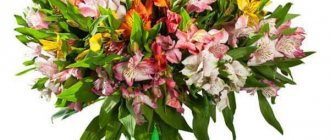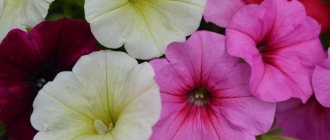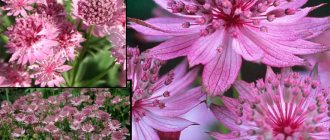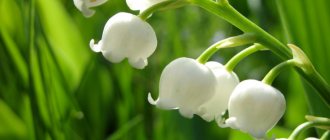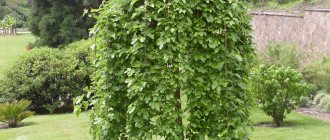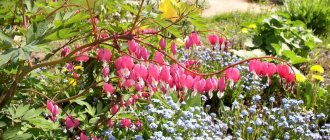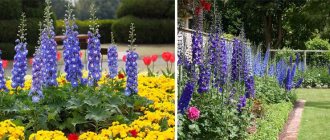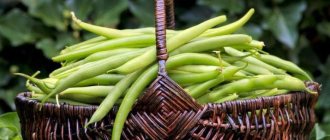- Care instructions
Petunias are incredibly beautiful flowers that are very popular among gardeners. Based on the shape of the plants and the type of shoots, numerous varieties of crops are divided into bushy (or bushy, erect) and hanging (or creeping, ampelous), which are grown in hanging containers or in open ground as ground covers. The differences between cascading petunias and hanging petunias are very conditional, so they are often classified in general as hanging species, separating cascade (or semi-ampeling) into a separate group or category.
Blooming petunia is a bright and original decoration for any garden plot, balcony or veranda
In the article we will talk in detail about the features of popular varieties, and also try to highlight the main differences that are important to consider when caring for plants.
History of the origin of petunia
For the first time, a flower called petunia was described by Jean Lamarck, a French biologist and scientist. The name is inextricably linked with the word petun - this is how tobacco is called in South America. Petunia is a herbaceous perennial belonging to the Solanaceae family.
Petunia pink
There are about 40 species in total, including a couple of annuals. The plant was brought to Europe in the 18th century. In Paraguay and Argentina, where petunia comes from, its length reaches 10 meters. The stems are erect or creeping; flowering begins in May and lasts until the first frost.
Petunia cascade
The cascade subspecies has four features that distinguish it from others, including hanging varieties:
- The shoots are thicker. They are well-fed and durable, and do not break from gusts of wind.
- The growth of green mass occurs due to aerial shoots. They point up, but then begin to droop down.
- If Petunia Cascade was planted in a flower pot, it looks like a huge ball with loops.
- The cascade subspecies also has rather large buds, reaching 5 cm.
Petunia
Landing Features
As a rule, the plant is grown from seeds. Planting and care begin as early as February, although sowing can be carried out until April. The mixture is bought in a store or prepared independently from peat, sand, humus, and turf soil in equal quantities. Expanded clay is used as drainage.
- Distribute the seeds evenly.
- Lightly sprinkle with soil, crushing it in a sieve.
- Spray with water from a spray bottle and cover with glass.
- Place in a well-lit room with a temperature of 18 to 24 degrees.
Lilac petunia flowers
The first 2 weeks of supercascade red petunia and other varieties are watered daily. A couple of crystals of potassium permanganate are thrown into the water for irrigation to prevent diseases and accelerate growth. The emerging sprouts are gradually hardened and taken outside. When representatives of the Solanaceae family grow up, they are planted in containers with peat. Then they add fertilizer.
Popular varieties
For several years now, these plant varieties have been particularly popular among flower growers. What varieties are we talking about?
- Gioconda. The bush is small, but there are many branches. Medium size flowers. Well adapted to temperature changes.
- Ramblin'. It grows up to 40 cm, but the shoots stretch another meter. Refers to early varieties.
Petunia red
There is also a giant cascade petunia or Supercascade. We are talking about a variety series of large-flowered plants that form entire cascades of flowers up to 12 cm in diameter. Blooms early and abundantly. In our country, supercascade white, supercascade pink, and giant petunia are often planted in balcony boxes and hanging baskets.
Reproduction methods
Petunia is propagated in two ways - vegetative and generative. In the first case, shoots are used, and in the second, seeds.
Seed propagation
Seeds are sown in February or early May . Usually already processed planting material is sold. Self-collected seeds must first be soaked for half an hour in a light pink solution of potassium permanganate, and then for 12-24 hours with a growth stimulator (in “Epin”, “Solution”).
Seeds are sown in a common container or in peat tablets. The difference between these methods is that in the first case you will have to pick the plants into individual containers, but in the second not.
Rules for growing seedlings:
- The container is filled with drainage, soil and watered. Seeds are sown in grooves 1 cm deep at a distance of 5 cm from each other. They are sprinkled with soil and sprayed with a growth stimulator solution.
- The container with the crops is covered with film and placed on the windowsill. Room temperature is used for cultivation.
- The soil is moistened as it dries from a spray bottle. The crops are ventilated daily for 15 minutes.
- When shoots appear, the ventilation time is increased. Then the greenhouse is dismantled.
- To stimulate growth, seedlings are sprayed with Epin solution or a light pink solution of potassium permanganate.
- After three true leaves appear, the seedlings are planted in individual pots (disposable plastic cups are suitable).
- Petunia can be transplanted into a large pot after six leaves appear.
Vegetative propagation
You can ask your neighbors for petunia shoots or cut them yourself from a mother plant dug up and brought into the house last year. Root cuttings as follows:
- Cuttings 10 cm long are cut from petunias. They are cleared of all leaves except the top two.
- The cuttings are dipped at the cutting site in a root formation stimulator (“Solution”) for a day. The cut is then dipped into the ash.
- The cuttings are planted in sand, which is watered with water at room temperature. The container is covered with film or glass.
- When the plant takes root and begins to throw out new leaves, it is transplanted into a pot with soil.
Ampelous petunia
On the same windowsill there is an ampelous and cascading petunia - what is the difference? To answer this question, let’s delve into the meaning of the word “ampelous”. Translated from German, the word ampel means “hanging vase.” Thus, flowers grown in hanging flowerpots and baskets are usually called hanging flowers. The ampelous petunia flower has thin and elastic shoots that fall down.
Petunia ampelous
The length depends on the variety, often reaching 120 cm. There are also low-growing variations 30-40 cm long. The leaves are soft, with barely noticeable fluff. The shape of the flower resembles a bell, diameter is 3-10 cm.
Varieties
Over the past 10 years, breeders have developed many hybrid varieties that are resistant to temperature changes and are characterized by abundant flowering. We list the best varieties of the plant:
- Surfinia. Grown by cuttings, the choice of shades is huge. Resistant to weather conditions, produces abundant branching.
Sophinia - The Snow Queen. The flowers are pale white in color and have a delicate aroma. The length of the shoots is average.
The Snow Queen - Velveteen. Unlike other varieties, ampelous petunias “Velvet” have an unusual velvety surface. It is highly valued by beekeepers as a honey plant.
- Avalanche. There are several variations: pink, purple and white. Decoration at a high level. Blooms for a long time, but is extremely fragile. Therefore, care must be extremely careful.
Petunia Avalanche - Opera. A plant with small buds colored pink, white or red.
- Catherine. A hybrid variety that will color your site in yellow and red tones.
Disembarkation
Provide your petunia with proper care - it will delight you with abundant flowering within 3-4 months. It is advisable to plant it in a flowerpot, since it does not grow so luxuriantly in standing containers.
- Seeds are sown in spring. After 2.5 months, the first buds will appear on small-flowered varieties; on large-flowered varieties, this happens after 3 months.
- Select loose, nutritious soil, which is moistened in advance before sowing. Drainage is one of the prerequisites. It is made from pebbles and expanded clay.
- Before planting, the seeds are soaked in potassium permanganate. The procedure is carried out at a temperature of 21-24 degrees. In a week the first shoots should appear.
Blue petunia - Wait until 3-4 leaves appear and dive to a permanent location. Several plants are planted in one pot for reliability.
- In order for petunia sprouts to take root, complex fertilizers are applied once a month. Flowering will be abundant and long-lasting if you add fertilizer containing magnesium and potassium to the soil.
- Maintenance is simple and boils down to abundant watering and regular loosening. On a hot day, ampelous petunia is moistened twice: in the morning and in the evening.
- There is another way to make flowering more magnificent. All dried buds must be removed. If necessary, transplant the flowers to a sunny place without drafts.
Reviews from flower growers
Olga, 35 years old, Ekaterinburg
As amateur gardeners, we always want to try something new. So I stubbornly did not want to plant classic petunias in my garden plot and was chasing expensive hybrids. But, as practice has shown, growing them is not so easy. For example, “Petunia F1 Hot Summer” gave only 50% germination, and out of 20 seeds of the fringed “Sleeping Beauty” only 3 germinated, and even then the sprouts were subsequently crushed in the flower garden. My best purchase was a mixture of hybrid petunia seeds. They are very cheap, there are 100 g of seeds in a pack (well, a lot!), and the germination rate is almost 100%. Of course, the flowers are not so bright, but they look great in large areas!
Valentina, 53 years old, Krasnoyarsk
Last year, seedlings of ampelous petunia Cascadias Rim Magenta No. 115 accidentally fell into my hands. I had never been involved in growing flowers before, but here I had to - I didn’t want the gift to go to waste. I read that such plants require spacious pots. Therefore, the first thing I did was transplant it into a large pot filled with 10-12 liters of a mixture of humus, sand and soil (added a little more perlite). I didn’t expect the plant to respond so quickly. After just 2 weeks it turned into a rather fluffy bush with a large number of leaves, under which the soil was no longer visible. There are an incredible number of flowers, they are cherry-purple, velvety, with a pale lemon border. The aroma of the flower is delicate and barely perceptible. The plant is extremely decorative, forms a dense spherical bush. It tolerates rain and wind easily. It loves watering, but drainage must be provided and should not be over-watered. Due to the abundant flowering, it requires regular feeding. I used complex fertilizers. It turned out that propagating this petunia is very simple. All you need is to break off a young shoot 10-12 cm high and place it in water with Kornevin for an hour, and then plant it in a glass with loose nutritious soil.
Inga, 40 years old, Kaluga region
Cascade petunias Marco Polo really do well without pinching, as agro specialists write on seed packets. For me, they sprouted well and began to bush immediately on their own.
Diseases, pests and their control
The lush flowering of petunias can be marred by some diseases and insects. If you take timely measures to combat the main enemies of the plant, the plants will be reliably protected all summer. In general, this is a very hardy and persistent representative of the flora. But since the southern beauty came to us from countries with a warm, humid climate, growing in temperate latitudes becomes a real test of strength for her.
Like other plants, ampelous and cascading petunias are susceptible to infection by thrips, aphids and spider mites. Small insects often go unnoticed, but mites can be recognized by their sticky webs and colonies on the undersides of leaves. Neoron, Apollo and other acaricides are used for treatment. Insecticides Konfidor and Aktara will help cope with dark thrips and aphids.
Most often, Petunia Cascade suffers from powdery mildew, which affects the upper part of the leaves. They begin to dry out and curl into a “boat”. Affected plants are burned, the rest are sprayed with garlic infusion, and the preparations Skor and Topaz are used. No less dangerous is gray rot, which affects the entire above-ground part. The fight pattern is the same.
New varieties
The pace of petunia (Petunia x hybrida) selection is not slowing down. Every year new products are introduced to meet changing expectations.
- A group of 10 varieties with a compact round shape. The shoots partially rise, partially hang down. The flowers are not very large, very numerous, evenly distributed on the shoots (an “empty” center is not formed).
- Circus Sky. A variety with unique pink flowers with a white edge (emphasizing the wavy edge of the petals), light stripes extending to the purple throat, and dots throughout the rest of the flower.
- Easy Wave and Shock Wave Purple Tie Dye. The Wave group of ampelous petunias celebrates its 25th anniversary on the market. New varieties: Shock Wave Purple Tie Dye - with very numerous and durable purple-blue-white flowers and Easy Wave Rose Fusion - with pink, darker veins. Recover quickly after rain.
- Cosmic Purple and Lucky Lilac. Two new varieties with interesting flowers - Cosmic Purple is dark burgundy with a pink border, Lucky Lilac is purple with a white star. Like other representatives of the GO! Tunia, they are very early (even in conditions of poor lighting and lower temperatures), compact.
- Hippy Chick Violet. A variety with very beautiful light purple flowers with a clear white border. The shape is round, slightly hanging, flattened at the top. It looks better in hanging containers and can be planted in compositions with other balcony and indoor plants.
- Itsy Magenta. Another member of the Itsy group with attractive dark pink tiny flowers with broadly rounded petals. They grow well and maintain a beautiful compact appearance. Suitable for growing in containers.
- Mystical Midnight Gold is a variety with unique lush flowers, with almost black petals with a pale yellow border. It reproduces very well and blooms profusely.
- Supertunia Vista Snowdrift is a variety with snow-white flowers, blooms profusely, grows intensively, and is resistant to unfavorable growing conditions. Works great in urban plantings, large containers (hanging), cascading structures, and flower beds.
- Surprise Sparkling is a group of varieties with unusual flowers with white speckles and slightly shiny petals in four colors: red-pink, deep purple, purple and dark blue. They branch well and bloom early.
Ampelous and cascading petunia: the main differences
We can conclude that there is a lot in common between hanging and cascading varieties. Not surprising, because they are closest relatives. Let's try to find out how one variety differs from another:
- The length of the shoots is different, and they grow differently. Only the cascade has the ability to pinch. Its shoots are flexible and succulent.
- Cascading curls beautifully - it is suitable for decorating fences and supports. Ampelnaya has proven itself well in hanging flowerpots.
- Giant cascading petunia is dotted with buds of the same size and color. Ampel ones come in different colors, and the size is different.
Bush
This group includes a large number of very different varieties, from those with compact and small bushes and flowers, for example, the Multiflora subgroup, in which flowers reach only 4 centimeters.
There are also quite large hybrids, such as Grandiflora, with beautiful voluminous flowers reaching 16 centimeters in inflorescence.
Such varieties are low-growing and if planted in large quantities, they will look great in the form of a flower bed or if planted along the borders, and if planted at home they will become an interesting window sill decoration.
This group has the most popular varieties, which are usually most often purchased by gardeners:
- Fantasy hybrid series
- Dream series - these varieties are low-growing, with a wide variety of colors
- For those who want to see flowers on their site as early as possible, a series such as Ultra is suitable
- Series of nine Titan hybrids
- Also early Polaris series
- For those who have a rather unstable climate, strong gusts of wind and rain, a series such as Storm is suitable
Basically, of course, petunias form their own shape, most often into compact bushes, but if desired, they can be adjusted and if you learn the correct pruning, when you cut off the crown above the third internode, then the plant begins to form new shoots and such a bush will be much more luxuriant.
Petunia in landscape design
An elegant and delicate flower is successfully used by designers when decorating country houses. On the one hand, carpet plantings have not yet become a thing of the past, on the other hand, containers and flowerpots are increasingly being used to decorate modern flower beds. For this design, planting ampelous petunia is best suited. To do this, the flowerbed is planted with green grass, and large flowerpots with “garlands” hanging down to the ground are placed nearby. They are also placed in the yard on tiles. Against the backdrop of the courtyard, the composition looks catchy and expressive.
There is no need to buy expensive flowerpots and containers. Instead, they take unnecessary pots and buckets, which are painted on the outside.
In addition, flower beds are placed under windows. The container is mounted on a wall or ebb. This simple trick ensures a great look both outside and inside. Another popular design option is placing flower beds in hanging pots. When the petunias bloom, the flowerpots will turn into bright, fragrant clouds under the roof. They can also be hung on the terrace or in the gazebo. The plant is so successful and easy to care for that you don’t even have to be sophisticated to create a luxurious landscape design. The result will definitely please you: a mesmerizing flowerbed, harmony and comfort next to the house, flowering paths and fences.


